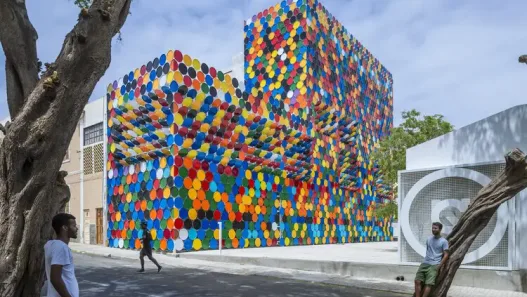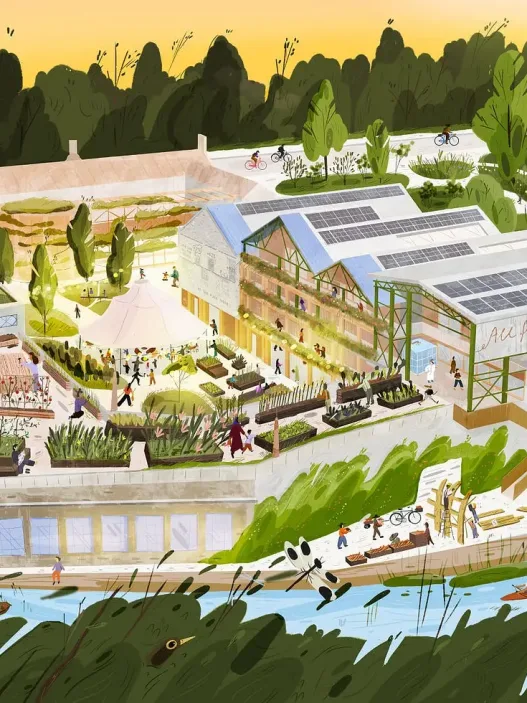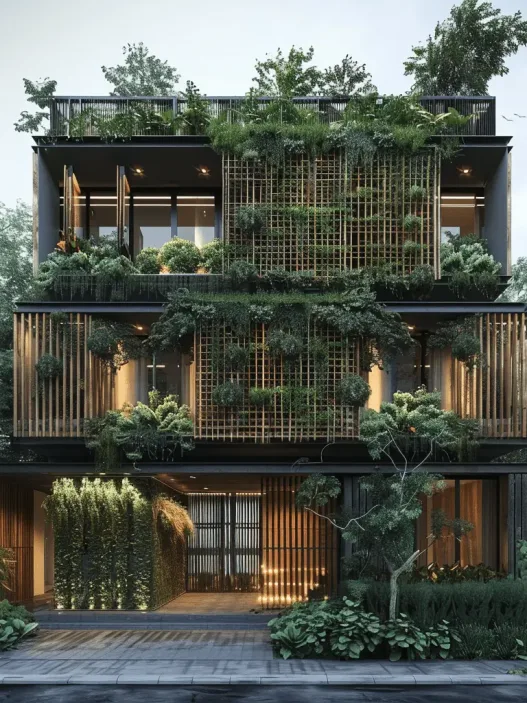In recent years, the architectural landscape has undergone a profound transformation with the integration of recycled materials. As the world grapples with challenges such as climate change and resource depletion, architects and builders are increasingly turning to materials that have been stripped of their original use.

This shift not only minimises waste, but also encourages a more sustainable approach to construction. By using recycled materials, we are not just designing buildings; we are creating stories that reflect our commitment to environmental stewardship.
In architecture, recycled materials refer to all materials recovered from previous uses and processed for reuse in new construction projects. This can include materials such as reclaimed wood, recycled metal, reused bricks and even glass and plastic. The essence of recycled materials lies in their ability to divert waste from landfill while providing new buildings with unique aesthetic qualities and historical narratives. They are often sourced from demolished buildings, industrial waste and even everyday consumer products, offering a diverse palette for architects and designers.
Importance in Sustainable Design
The importance of recycled materials in sustainable design cannot be overstated. They play a crucial role in reducing the environmental impact of construction by reducing the demand for new raw materials. This reduction not only conserves natural resources, but also reduces the energy consumption associated with material extraction and processing. Furthermore, the use of recycled materials can make a tangible contribution to climate change mitigation by significantly reducing greenhouse gas emissions. In a world where sustainability has become a fundamental principle of design, the adoption of recycled materials offers architects a way to create environmentally sensitive and innovative buildings that are in line with contemporary values.
Historical Context
The use of recycled materials is not a new concept; it has deep historical roots. Throughout history, cultures have reused the materials they needed, whether due to scarcity or economic concerns. For example, the ancient Romans recycled bricks from old structures to build new ones, reflecting a practical approach to resource management. In the 20th century, this idea gained traction during periods of scarcity, such as after the Second World War. However, in the late 20th and early 21st century, with increasing environmental awareness, the use of recycled materials began to gain widespread acceptance in architectural practice. This historical context underlines a long-standing relationship between people and their materials and emphasises a cyclical approach to construction that is compatible with sustainable practices.
Current Trends in Architecture
Today, the architectural community is witnessing a vibrant revival in the use of recycled materials. Modern architects are exploring innovative ways to incorporate these materials into their designs, resulting in unique aesthetic and functional benefits. For example, buildings constructed from reclaimed wood not only provide warmth and character, but also tell a story of their previous lives. In addition, advances in technology have improved the processing and preparation of recycled materials, making them more accessible and easier to work with. Trends such as upcycling (the transformation of waste materials into new products) are gaining popularity, allowing architects to create bespoke elements that are both sustainable and visually striking. This contemporary focus on recycled materials reflects a broader cultural shift towards sustainability, where aesthetics and environmental responsibility go hand in hand.
Case Study Overview
Numerous case studies illustrating the successful integration of recycled materials into architecture demonstrate the potential and versatility of these materials. One notable example is the **High Line**, an elevated park built on a former railway line in New York City. This project not only transformed the urban area, but also celebrated the history of the site by using reclaimed materials throughout its design, providing a green oasis in a crowded city. Another inspiring example is the **Pavilion of Reflections** built for the World Fair in Milan. Designed using recycled materials such as wood and glass, it emphasises the importance of sustainability in modern architecture. These case studies pave the way for a more environmentally conscious future in architectural design by highlighting how recycled materials can enhance a building’s narrative, promote sustainability and inspire communities.
In conclusion, the use of recycled materials in architecture is more than a trend, it is a vital component of sustainable design that addresses ecological concerns while celebrating creativity and innovation. As we continue to explore the possibilities of these materials, we open doors to new narratives, unique designs and a more sustainable world.
Benefits of Using Recycled Materials
The construction industry is evolving to embrace sustainability in a way that not only benefits the environment, but also improves building performance and community well-being. One of the most significant changes is the use of recycled materials in construction. This practice not only reduces waste, but also brings numerous benefits that can transform the way we build and live in our spaces.
Environmental Impact
The use of recycled materials in construction plays a critical role in reducing our environmental footprint. Conventional building materials often require extensive resource extraction, which can lead to habitat destruction, pollution and a significant carbon footprint. When we use recycled materials, we effectively minimise the demand for new resources. For example, using reclaimed wood reduces the need for logging, protecting forests and the biodiversity within them.
Recycling also diverts waste from landfills where it would otherwise contribute to greenhouse gas emissions. The total volume of waste can be reduced by processing and reusing materials such as concrete, glass and metal. This process not only conserves natural resources, but also promotes a circular economy where materials are continuously reused and repurposed, rather than discarded after a single use.
Cost Effectiveness
Economic considerations are very important in construction and the use of recycled materials can lead to significant cost savings. Initially, there may be a perception that recycled materials are of lower quality or require more effort to source. However, many recycled products are competitively priced, especially when considering the savings they can make in the long term.
For example, using reclaimed brick or recycled concrete can often be cheaper than new materials, especially when the costs associated with extracting, processing and transporting new materials are taken into account. Furthermore, using recycled materials can further increase cost-effectiveness by reducing waste disposal fees. The initial investment in sustainable practices can yield significant returns over time, making it a financially wise choice for builders and developers.
Aesthetic Value
Recycled materials can give buildings unique aesthetic qualities, offering character and charm not found in new materials. For example, reclaimed wood often has different textures, colours and histories, allowing architects and designers to create spaces that tell a story. This adds depth and authenticity to a project, making it more attractive to both residents and visitors.
Furthermore, the trend towards industrial and rustic designs has made the use of recycled materials increasingly popular. Elements such as salvaged metal, glass and even plastic can be creatively integrated into modern architectural designs to create visually striking and innovative structures. Architects can push the boundaries of creativity while promoting sustainability by favouring recycled materials.
Improving Building Performance
The use of recycled materials can significantly improve the performance of buildings. Many recycled products have natural properties that improve energy efficiency and durability. For example, recycled insulation materials often provide better thermal performance compared to their conventional counterparts, helping to maintain comfortable indoor temperatures and reduce energy consumption.
Furthermore, materials such as recycled concrete aggregate can improve the structural integrity of buildings, making them more resilient to environmental pressures. This not only contributes to the longevity of the structure, but also reduces the need for frequent repair and replacement, leading to lower maintenance costs over time. As energy efficiency becomes increasingly important in building design, the role of recycled materials in improving performance cannot be overlooked.
Societal and Social Benefits
The benefits of using recycled materials go beyond the environmental and economic dimensions, encouraging community involvement and social responsibility. By sourcing materials locally, builders can support local economies, create jobs and stimulate growth within the community. This not only strengthens economic ties, but also fosters a sense of pride and ownership among local residents.
Furthermore, projects using recycled materials often act as a catalyst for community awareness of sustainability and environmental stewardship. They can inspire other developers and individuals to adopt similar practices, creating a ripple effect that encourages green building initiatives on a larger scale. This collective movement towards sustainability can lead to healthier communities with improved air quality and reduced pollution levels.
In conclusion, the benefits of using recycled materials in construction are vast and multifaceted. From minimising environmental impact and reducing costs to improving aesthetics and building performance, recycled materials make a compelling case for a more sustainable future in architecture and construction. By adopting these practices, we not only improve our built environment, but also contribute to the well-being of our communities and the planet.
3. Types of Recycled Materials in Construction
As the world becomes increasingly aware of environmental issues, the construction industry is evolving towards embracing sustainability. One important aspect of this shift is the use of recycled materials in building projects. By reusing materials that would otherwise end up in landfills, architects and builders can reduce waste, conserve natural resources and lower the carbon footprint of new structures. Let’s explore the various types of recycled materials commonly used in construction, their benefits and real-world applications.
Recycled Wood
Recycled wood is a versatile material that adds character and warmth to buildings. This wood is often obtained from demolished buildings, old pallets or timber reclaimed from forests. Using recycled wood not only diverts waste from landfills, but also helps protect forests by reducing the demand for new timber.
One of the most important benefits of recycled wood is its unique aesthetic. Each piece tells a story, showcasing the natural wear and history of the material. This can add a rustic charm to homes, restaurants and offices. In addition, recycled wood is often stronger than new wood because it has been seasoned over time.
In practice, many modern homes use recycled wood for flooring, beams and furniture. Notable examples include restaurants that use reclaimed barn wood in their interiors, creating an inviting atmosphere while promoting sustainability.
Recycled Metal
Recycled metal, especially steel and aluminium, has become a cornerstone of sustainable construction. Metals are extremely durable and can be recycled indefinitely without losing their properties. This means that materials from old buildings can be melted down and reused as new structural elements, roofing or even decorative features.
The use of recycled metal significantly reduces energy consumption compared to the production of new metal from raw ores. It also minimises mining activities that can be harmful to the environment. Many skyscrapers and commercial buildings today utilise recycled steel for their frames, demonstrating not only strength but also a commitment to sustainability.
Some innovative designs utilise recycled metal in creative ways, such as artistic facades or furniture pieces. For example, artists have demonstrated the infinite possibilities of this material by transforming old metal scraps into striking sculptures that double as architectural elements.
Recycled Glass
Recycled glass is becoming increasingly popular in the construction industry, mainly due to its aesthetic appeal and versatility. This material can be found in a multitude of applications, from decorative tiles and worktops to insulation and in some cases even structural elements.
One of the remarkable aspects of recycled glass is that it can be melted down into new products without any deterioration in quality. This means that glass can be recycled more than once, making it an excellent choice for sustainable construction.
In real-world applications, many modern buildings utilise recycled glass in their design. For example, glass tiles made from recycled materials can add vibrant colours and unique textures to walls and floors, while glass facades can improve energy efficiency by allowing natural light while reducing heat loss. This not only contributes to the aesthetics of the building, but also supports energy savings.
Reclaimed Stone
Reclaimed stone offers a timeless quality that is difficult to replicate with new materials. Such stone is often sourced from old buildings, roads or quarries, giving it a weathered charm that can enhance the beauty of new structures.
The use of reclaimed stone not only reduces the demand for new quarries, but also offers a sustainable solution for the preservation of historic materials. These materials can include bricks, paving stones and larger blocks of stone, each with unique textures and colours that tell the story of the past.
Architects and builders often use reclaimed stone in landscaping, exterior cladding and even in the creation of stunning interior features such as fireplaces. Notable projects showcased reclaimed stone in modern designs that blend old-world charm with contemporary aesthetics, proving that sustainability can be both functional and beautiful.
Innovative Composite Materials
The construction industry is also witnessing the emergence of innovative composite materials made from recycled content. These materials combine various substances to create new and durable construction options. They can include recycled plastics, wood fibres and mixtures of other materials, resulting in products that are not only strong but also lightweight and weather-resistant.
Composite materials are particularly advantageous for outdoor applications such as decking and fencing where traditional materials may be subject to decay or deterioration. By utilising recycled components, these composites can significantly reduce environmental impact while providing long-lasting performance.
A growing trend in urban development involves the use of these innovative composites in public spaces such as parks and playgrounds, where they contribute to sustainable practices while providing safety and durability. Projects using recycled composite materials often highlight their colourful designs and unique textures, appealing to both environmental sensibilities and aesthetic preferences.
In conclusion, the use of recycled materials in construction is not just a trend; it is a movement towards a more sustainable future. By choosing materials such as recycled wood, metal, glass, reclaimed stone and innovative composites, builders and architects can create structures that are both beautiful and environmentally responsible. Each choice contributes to a larger goal: to reduce waste, conserve resources and inspire the next generation of sustainable design.
4. Case Studies of Architectural Masterpieces
Architecture is not just about buildings; it is a reflection of culture, innovation and sustainability. Masterpieces of architecture often tell stories about their surroundings and the people who live in them. In this section, we look at a few iconic buildings that have had a significant impact on their cities and the world at large.
High Line, New York
The High Line is a remarkable example of urban regeneration and innovative design. Once an abandoned elevated railway, this linear park stretches for nearly a kilometre along the West Side of Manhattan. It was conceived as part of a broader movement to revitalise underused urban spaces. The project began in 2006 with community efforts and a vision to transform the building into a public green space.
As you walk along the High Line, you encounter a blend of nature and urban life. The park features lush gardens, art installations and seating areas, providing a tranquil escape from the bustling city below. The design emphasises sustainability by incorporating native plants that require minimal maintenance and water. The High Line has become a symbol of how cities can adapt and evolve by promoting biodiversity while providing a vibrant public space.
The real-world application of the High Line concept has inspired similar projects around the world, such as the High Line’s sister project, the Low Line, which aims to create an underground park. The success of the High Line has also influenced urban planners to rethink the potential of old infrastructure and demonstrated the importance of community participation in shaping public spaces.
Bosco Verticale, Milan
Bosco Verticale, or “Vertical Forest”, is a pioneering residential project in Milan that seamlessly integrates nature into high-rise living. Completed in 2014, this innovative design includes two towers adorned with more than 9,000 trees, 20,000 plants and 100,000 shrubs. The concept behind Bosco Verticale is not only aesthetic; it aims to combat urban pollution and improve the quality of life of residents.
The towers rise metres high, creating a unique silhouette and adding greenery to the urban environment. Each balcony acts as a mini garden, encouraging biodiversity in the heart of the city. The presence of plants helps regulate temperatures, improve air quality and provide habitats for birds and insects. This project exemplifies how architecture can respond to environmental challenges and promote sustainability.
Bosco Verticale has received international acclaim and has inspired similar vertical forest projects around the world, from China to France. The success of this project highlights the potential to make cities more liveable and environmentally friendly by integrating nature into urban design.
Eden Project, Cornwall
The Eden Project in Cornwall, England, is often referred to as the “eighth wonder of the world”. This extraordinary complex consists of a series of geodesic domes that house a variety of ecosystems that showcase the beauty and fragility of our planet. Opened in 2001, the Eden Project aims to educate visitors about the importance of biodiversity and sustainable living.
The biomes are home to thousands of plant species from a variety of climates, including tropical rainforests and Mediterranean gardens. Each biome is carefully designed to mimic its natural environment, providing insight into the ecosystems that sustain life on Earth. The project goes beyond simply displaying plants, emphasising the interconnectedness of humanity and nature and encouraging visitors to reflect on their environmental impact.
The Eden Project has also become a model for sustainability in architecture. It inspires action against climate change using renewable energy sources, rainwater harvesting and educational programmes. The success of this initiative has encouraged similar initiatives around the world and reinforced the idea that architecture can play an important role in promoting environmental awareness.
Bullitt Centre, Seattle
The Bullitt Centre stands as a beacon of sustainability in the heart of Seattle. Completed in 2013, this office building was designed to meet the rigorous standards of the Living Building Challenge, a sustainable building certification programme. The Bullitt Centre demonstrates a commitment to renewable energy, water conservation and sustainable materials.
One of its highlights is its solar panel array, which generates more energy than the building consumes, making it a net-zero-energy structure. The building also features a rainwater harvesting system that provides all the water needed for the building’s occupants. Inside, the design prioritises natural light and promotes a healthy working environment through the use of non-toxic materials.
The Bullitt Centre serves as an educational platform, hosting tours and workshops to share its sustainable practices with the community. The success of this project has inspired other developers to adopt similar eco-friendly approaches, demonstrating that sustainable architecture is not only feasible but also essential to addressing today’s environmental challenges.
The Crystal, London
The Crystal in London is an architectural marvel dedicated to sustainable urban living. Opened in 2012, this innovative building serves as a learning centre about smart cities and future urban solutions. Designed to be one of the world’s most sustainable buildings, The Crystal is powered by renewable energy sources and incorporates the latest technologies.
The building’s design emphasises transparency and connection to the environment, with expansive glass facades that invite natural light and offer stunning views of the surrounding landscape. Inside, interactive exhibitions and displays engage visitors in discussions about sustainability, urban planning and community engagement.
Crystal is not just a building; it represents a vision for the future of cities. It hosts events, workshops and conferences that bring together leaders in sustainability and urban design. Acting as a catalyst for change by encouraging dialogue and collaboration, The Crystal inspires cities around the world to adopt more sustainable practices. As a result, these architectural masterpieces demonstrate how design can enhance urban life, support sustainability and encourage community engagement. Each project tells a unique story, contributing to the wider narrative of how we can create a more harmonious relationship between people and the environment. Through these case studies, we see the potential of architecture to positively shape our world.
5. Challenges in the Application of Recycled Materials
In recent years the construction industry has become increasingly aware of the importance of sustainability, leading to a growing interest in the use of recycled materials. While this shift offers numerous benefits, such as reduced environmental impact and resource conservation, it also brings with it a number of challenges that need to be addressed for successful implementation. Understanding these challenges is crucial for architects, builders and policy makers seeking to effectively integrate recycled materials into their projects.
Availability and Resource Utilisation
A major challenge in the utilisation of recycled materials is the availability and procurement of these materials. Recycled materials can vary greatly in quantity and quality depending on the region and local recycling infrastructure. For example, in urban areas with strong recycling programmes, it may be easier to source reclaimed wood or recycled metals. In contrast, options may be more limited in rural areas.
In addition, the logistics of collecting, processing and transporting these materials can make sourcing difficult. Builders may find that while recycled materials are available, they are not always readily accessible or economically procurable. This can lead to delays in projects and increased costs, discouraging their use. To address these issues, innovative partnerships between construction companies and recycling facilities need to be established and a more reliable supply chain for recycled materials needs to be promoted.
Quality Control Issues
Quality control is another critical challenge when using recycled materials in construction. Unlike new materials, which are typically held to strict standards, recycled materials can exhibit significant variability in quality. This can include inconsistencies in strength, durability and appearance that can affect the overall integrity of a building.
For example, reclaimed timber may contain knots, splits or insect damage that can compromise its structural capabilities. Similarly, recycled concrete may not always meet the specifications required for load-bearing applications. To mitigate these risks, recycled materials need to be thoroughly tested and evaluated before they are used in construction. The establishment of standardised testing protocols and the development of best practices for material evaluation can help to ensure that recycled materials are safe and reliable for construction purposes.
Regulatory and Compliance Barriers
Another barrier to implementing recycled materials is legal regulations. Building codes and regulations often prioritise new materials that meet set standards, which can create barriers for recycled alternatives. Many jurisdictions have specific requirements for materials used in construction, and recycled materials may not always fit within these frameworks.
To overcome these challenges, it is crucial that industry stakeholders engage with regulators to advocate for the inclusion of recycled materials in building codes. Joint efforts to update regulations can stimulate innovation and promote the use of sustainable materials in construction. Furthermore, sharing examples of successful projects where recycled materials have been used effectively can help build confidence among regulators and the public in the safety and reliability of these materials.
Market Perception and Acceptance
The perception of recycled materials is also a challenge in their implementation. Despite increased awareness of sustainability, some consumers and builders remain sceptical about the quality and performance of recycled materials. This scepticism can stem from misconceptions or a lack of knowledge about how these materials are sourced and processed.
Education and outreach are crucial to promote market acceptance. Information campaigns that emphasise the benefits of recycled materials, showcase successful projects and dispel myths can help change public perception. Furthermore, architects and designers play a vital role in demonstrating the aesthetic and functional potential of recycled materials through innovative design solutions. When consumers can see and experience first-hand the quality of recycled materials, they are more likely to adopt them in their projects.
Overcoming Design Limitations
Finally, design limitations can pose a significant challenge when integrating recycled materials into construction projects. The unique characteristics of recycled materials may not always be compatible with traditional design practices and standards. For example, the dimensional variability of reclaimed wood or aesthetic differences in recycled plastics can make it difficult to achieve a harmonised design.
But these challenges can also inspire creativity and innovation. Architects and designers can explore new design paradigms that celebrate the unique qualities of recycled materials. By embracing the imperfections and distinctive characteristics of these materials, designers can create visually stunning and environmentally friendly spaces. Collaborating with materials scientists and engineers can also lead to the development of new applications and techniques that enhance the performance and versatility of recycled materials in construction.
In conclusion, although the application of recycled materials in construction presents several challenges, addressing these issues can lead to significant advances in sustainable building practices. By focusing on availability and procurement, quality control, regulatory compliance, market perception and design constraints, the construction industry can pave the way for a more sustainable future. The adoption of recycled materials not only contributes to environmental protection, but also encourages creativity and innovation in the architectural landscape.
6. Future of Recycled Materials in Architecture
The future of recycled materials in architecture is a fascinating topic at the intersection of sustainability, innovation and design. As the global community becomes increasingly aware of environmental issues, architects and builders are looking for ways to reduce waste and optimise resource use. Recycled materials not only help to conserve raw materials, but also minimise the environmental impact of construction. In this section, innovations in materials science, policy changes, public awareness, the role of technology in design and the vision of sustainable urban development will be discussed.
Innovations in Materials Science
The evolution of materials science is paving the way for exciting developments in the use of recycled materials in architecture. Researchers are developing new ways to process waste products, turning what was once considered rubbish into valuable building materials. For example, innovative techniques are being used to create high-performance concrete that incorporates recycled aggregates from demolished buildings. This not only reduces the need for virgin materials, but also increases the strength and durability of structures.
Furthermore, the emergence of bioplastics derived from organic waste presents an interesting opportunity for architecture. These materials can be produced to mimic traditional building materials while being biodegradable and environmentally friendly. The potential for recycled textiles to be used in insulation and even as structural components is also growing. Such innovations not only contribute to sustainability, but also inspire architects to think creatively about how to integrate recycled materials into their designs.
Policy and Regulatory Changes
As the architecture industry moves towards sustainability, policy and regulatory frameworks are evolving to support the use of recycled materials. Governments around the world are implementing stricter building codes and incentives that encourage the incorporation of sustainable practices. For example, some cities offer tax rebates for buildings that use a certain percentage of recycled materials or projects that receive green certification.
Furthermore, international agreements aimed at combating climate change are forcing the adoption of circular economy principles in construction. This means that materials are not only recycled but also designed to be reused at the end of their life cycle. By establishing policies that prioritise the use of recycled materials, governments can drive change in the construction industry and ensure that sustainability is integrated into the foundation of architectural practice.
Increased Public Awareness
Public awareness of environmental issues and sustainability is increasing, and this change is having a significant impact on architectural practice. As people become more aware of their ecological footprint, they are demanding greener buildings and sustainable practices from architects and builders. This increased awareness is leading to a preference for structures using recycled materials, which not only reduces waste but also tells a story of environmental stewardship.
Educational initiatives and campaigns are helping to spread the word about the benefits of recycled materials in architecture. Workshops, seminars and community projects are engaging the public and showing how recycled materials can be used effectively in construction. This growing enthusiasm in society encourages architects to incorporate these materials into their designs, further spreading the culture of sustainability.
The Role of Technology in Design
Technology plays an important role in the integration of recycled materials into architectural design. Advanced software and modelling tools enable architects to analyse the life cycle of materials, assess their environmental impact and optimise their use in projects. Building Information Modelling (BIM), for example, allows simulation of building performance with various recycled materials, helping architects make informed decisions that balance aesthetics, functionality and sustainability.
Moreover, the rise of 3D printing technology is revolutionising the use of recycled materials. This technique allows the creation of complex structures using recycled plastics and other materials, opening up new possibilities for innovative design. Architects can push the boundaries of creativity by utilising technology and at the same time lead to a more environmentally sensitive built environment by adhering to sustainable practices.
Vision for Sustainable Urban Development
Looking to the future, the vision of sustainable urban development is inextricably linked to the use of recycled materials in architecture. Cities are redesigning their landscapes to be more resilient, resource efficient and environmentally friendly. This vision includes not only constructing new buildings with recycled materials, but also retrofitting existing structures to improve their sustainability.
Urban planners and architects are increasingly collaborating to create areas that prioritise green infrastructure, such as parks and green roofs where recycled materials can be used. The concept of “urban mining”, where materials from demolished buildings are reused in new projects, effectively closing the waste cycle, is gaining traction. This holistic approach to urban development not only enhances the aesthetic appeal of cities, but also contributes to a healthier environment for residents.
In conclusion, the future of recycled materials in architecture is bright and full of potential. Innovations in materials science, supportive policies, increased public awareness, technological advances and a commitment to sustainable urban development are the driving forces that will shape how we build and live our spaces. As we embrace these changes, the architectural landscape will not only reflect our commitment to sustainability, but also inspire future generations to think creatively about the materials we use and their impact on our planet.





















